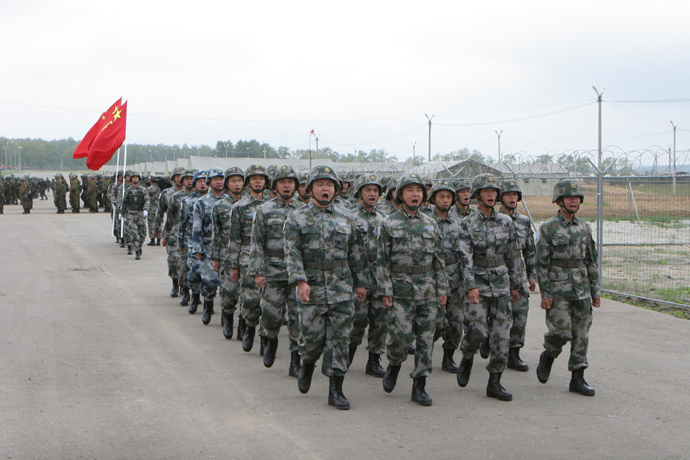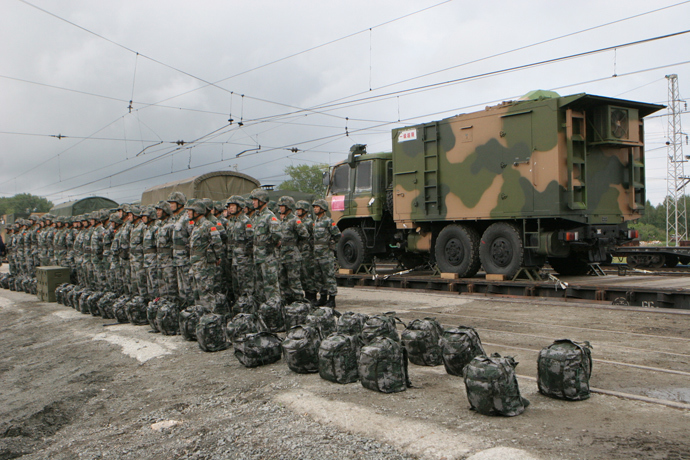Chinese military hardware hits Russia for joint anti-terror drills
Russian-Chinese anti-terror drills are in full swing with the latter's tanks and gunships training at a military range in the Urals. It comes less than a month after joint naval drills, the largest of their kind China has participated in to date.
The joint counter-terror exercises, codenamed Peace Mission 2013,
went live on Saturday and will last until August 15.
“The key goal of the upcoming maneuvers is to organize the
joint work by control authority and troops to prepare and conduct
military actions during the anti-terrorist operation. The
maneuvers will take place in three stages, which include the
re-deployment of troops, the planning of the operation and joint
military actions,” a military press release said.
Maneuvers have been prepared by the United Strategic Command of the Russian Central Military District and the Shenyang Military Region of the People’s Liberation Army of China.

The drills at the Chebarkul military training area in the Chelyabinsk region involve 1,500 personnel, 600 of whom are Chinese servicemen. Overall 250 pieces of military hardware are taking part in the exercises, as Chinese troops brought along their own tanks, light reconnaissance vehicles, 120-mm self-propelled howitzers, 152-mm self-propelled guns, JH-7A ‘Flying leopard’ fighter-bombers and Harbin Z-9 gunships and Mi-171 transport helicopters.
The distance between Shenyang Military Region and the Chebarkul military range is well over 4,000 kilometers. While Chinese troops and armored vehicles were delivered to the training area in Russia’s Urals by railway, the helicopters and fighter jets covered the distance with a number of refueling landings. The logistical challenges were demonstrated by Chinese gunships and transport helicopters - accompanied by Russian Mi-8 military helicopters - which had to stop eight times to reach the Chebarkul range. It has been reported that all the combat systems and munitions aboard the Chinese aircrafts remained deactivated during their flight through Russian airspace.

On August 1 a Chinese task force deployed to Russia celebrated
the birthday of the People’s Liberation Army of China while
training with Russian servicemen.
“We’re glad that both countries have a high level of mutual
trust. We’re not competitors, but we’re partners. Trust between
the two countries became the unique feature of the Peace
Mission,” Shi Xiangyuan, deputy chief of staff of the
Shenyang Military Region of the People’s Liberation Army, told
ITAR-TASS news agency on Saturday.
“We’re pleased that we are conducting the exercises in the
military district which hosts 40 percent of Russia’s armed
forces. I’m sure that the Peace Mission 2013 will yield results.
This is a new stage of military cooperation between the Chinese
and Russian armies,” the Chinese military said, stressing
that strategic cooperation between the Russian and Chinese armies
had reached an unprecedented level in the recent years.

While preparing for the exercise, Russia and China held
three conferences and also conducted reconnaissance operations.
The Russian military group is led by deputy chief of staff of the
Central Military District Major-General Sergey Chuvakin. China’s
group is under the command of the deputy chief of staff of the
Shenyang Military Region Zhang Yan.
The joint command of Peace Mission 2013 involves 60 Russian and
Chinese staff officers. The ground operation portion of the drill
will be performed by a battalion task group and Chinese tactical
units. A united air group, including bombers and gunships, will
provide air support for the ground forces.
At a media conference that introduced the exercises, Shi
Xiangyang relayed to reporters a Chinese proverb, saying “We
don’t seek to be number one, but we seek perfection.”
Just like the Russian army, the People’s Liberation Army of China is undergoing technical and structural reforms right now. Joint exercises like Peace Mission 2013 are called with an eye to helping both armies to strive as close to perfection as possible.

Economic and diplomatic ties between Moscow and Beijing have gotten increasingly close in recent years. The positions of the two countries have mostly coincided on a large number of major issues in geopolitical affairs, as Russia and China have presented a united front in the UN and other international organizations.
China is becoming Russia’s priority market at an accelerating rate, as Moscow is shifting its economic priorities from Europe to Asia, boosting trade ties with the world’s second largest economy.
In spring 2013 the newly elected Chinese President Xi Jinping chose Russia as primary destination for his first international visit. The package of energy deals he signed in Moscow with his Russian counterpart Vladimir Putin has guaranteed that China will become Russia’s primary energy market within the next several years.
Russia and China have already held a number of joint military exercises since 2005. The joint naval exercises in 2013 were the largest ever between the two states.

All Russian-Chinese war games are organized within the framework
of the Shanghai Cooperation Organization (SCO), which was founded
in 2001. The SCO comprises China, Russia and four Central Asian
countries: Kazakhstan, Kyrgyzstan, Tajikistan and Uzbekistan.
The SCO member states coordinate efforts to jointly counter
terrorism, while also consolidating efforts in other areas such
as politics and trade.














